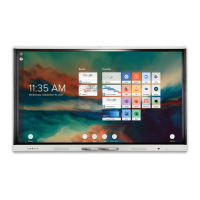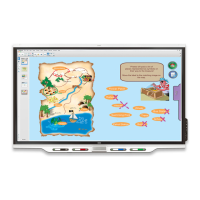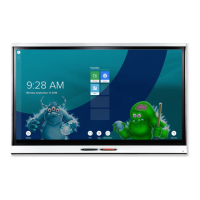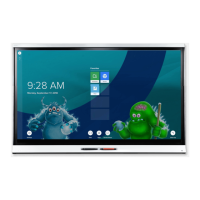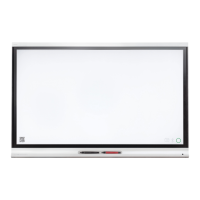Chapter 6
Troubleshooting the display
smarttech.com/kb/171745 73
Symptom Troubleshooting steps
Colors don’t appear correctly. l Check the Image mode settings.
See the SMARTBoard GX series interactive displays installation and maintenance
guide (smarttech.com/kb/171744).
l Be aware that if two or more displays are mounted side-by-side, there will be minor
differences in colors across the displays. This issue is not unique to SMART products.
l If the screen is completely lacking one color or the color problems occur on the Home
screen, provide a photo of the screen to SMART support.
l If you’re using an analog video input, such as VGA, AV, or YPbPr, use a different cable
or connect a different source to see if the issue is with the cable or input source.
The image is cut off or shifted to the
left or right.
l Adjust any connected computer’s video settings, particularly zoom, crop, and
underscan.
See the computer’s operating system documentation.
l If any connected computers’ desktops are entirely black, change them to dark gray or
a different color.
l If any connected computers’ desktops are extended across multiple screens,
duplicate the desktops across the screens or set the display as the only screen.
The image doesn’t fill the entire
screen.
l Adjust any connected computers’ video settings, particularly overscan.
See the computer’s operating system documentation.
l Make sure the connected computer’s video connector is configured to output a
supported video signal. See No video display output from a laptop.
A persistent image appears on the
display.
l See Image persistence or burn in on LCD displays.
The video from a device connected to
the display’s USB Type-C connector
doesn’t appear on the display’s
screen.
l Make sure the connected device supports Display Port Alternate Mode via USB Type-
C. If there is no DP logo beside the USB Type-C connector on the device, it may not
support Display Port Alternate Mode.
l Make sure the cable connecting the device to the display supports SuperSpeed USB
data speeds of 5 Gbps (or above). The cable should be marked with the SuperSpeed
USB logo. The absence of this logo may indicate the cable doesn’t support a
SuperSpeed USB data connection that’s required for Display Port Alternate Mode.

